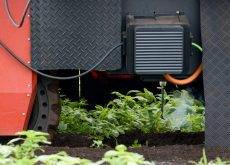Last year, Paul Wipf put up 10,000 tonnes of silage, but it wasn’t made with just any old ingredients. The Viking Hutterite colony farm manager is choosy about what goes into the silage pit.”I look for quality of feed first and good yield,” said Wipf, who has slowly moved from cereal crop to corn silage.Last year, 650 acres of the 1,000 acres of silage on their central Alberta colony was corn silage. The rest was cereal silage, seeded as an insurance policy for dry weather or a complete corn crop failure. He’s planted the same corn and cereal crop silage acres this year.At $75 to $100 an acre for seed and fertilizer, corn silage is more expensive, but Wipf believes it works out cheaper than cereal silage in the end because of better overall health of their dairy cattle.Wipf maintains the cattle have fewer retained placentas, better cycling and lower veterinary bills since they were fed corn silage.On the production side, Wipf said he’s still learning how to get a good, consistent yield with corn silage. The colony has switched from an air seeder to a corn planter to increase yield and it doesn’t scrimp on fertilizer.Last year’s dry, cool spring delayed corn development, but once it rained in July, the crop caught up and passed the cereal crops.Greta Schmidt of Falun, Alta., switched to growing corn silage from triticale silage about four years ago because it offered better yield and better silage properties.”Corn yields better and it makes a better silage. The cattle just love it,” she said.”Even last year with drought we had quite a good yield.”The corn yielded about 10 tonnes per acre, but it’s not uncommon to get 15 to 20 tonnes per acre of corn. While Schmidt liked the triticale silage, it was difficult to get it out of the field and volunteers became a nuisance the following year.Barry Yaremcio, forage specialist with Alberta Agriculture, said producers have many choices when choosing a silage crop. They can choose annual crops like barley, oats, wheat, triticale, canola or corn, or they can choose perennial forage and grass crops. They can put it in a pit, bag or pile.”There are a number of combinations,” said Yaremcio.According to the 2006 Statistics Canada Census of Agriculture, Alberta farmers grew 70,411 acres of corn for silage and 373,000 acres of cereal crop for silage.Over the past 10 years, new corn silage varieties have been developed to produce higher yields in Alberta’s cooler climate, but there is no guarantee of a good yield, Yaremcio said.”Over the last 10 years, only two out of the10 years have been adequate (for corn production) where corn was more profitable than cereals in the non-traditional corn growing areas.”Yaremcio recommends farmers experiment with 10 to 50 acres of corn silage the first year.Barley silage is the most common cereal used for silage, followed by a barley-oat or barley-triticale mix. Wheat and canola are normally used as silage only if the crop is frozen or drought stressed.Grass and perennial hay are the most common crops used in round bale silage. Perennial grasses and legumes are also used as silage but their low amount of available soluble sugar to start the fermentation process can be a problem.Alfalfa at full bloom has seven to nine percent water soluble carbohydrates compared to barley at 24 percent in the soft dough stage and corn at 31 percent.The higher the water soluble carbohydrates, the faster the fermentation process begins and the less dry matter loss.Yaremcio said he believes silage is losing popularity because of its cost and the amount of labour required to cut, truck and pack the silage.”The days of having neighbours getting together and silaging 2,000 acres between them are gone,” he said.Instead, producers must scramble to find help or must hire a commercial operator to cut the silage.Yaremcio said for many producers a 30 percent cost savings with swath grazing or baling is enough to cause them to lean away from silage.The advantage of silage for larger producers is that it is less work than hauling bales. Instead of 12 to 15 bales a day, the cattle can be fed with two or three loads of silage.”Silage is more efficient than round bale hay.”
Read Also

Government, industry seek canola tariff resolution
Governments and industry continue to discuss how best to deal with Chinese tariffs on Canadian agricultural products, particularly canola.
















